Glasgow Corporation Tramways
History
During the early-to-mid 1860s, Glasgow Corporation steadfastly opposed all tramway development within the city, however, by the late 1860s, with impending legislation that would enable promoters to obtain parliamentary powers to build tramways (under the Tramways Act, 1870), the corporation suddenly found itself faced with two schemes that might well succeed. The corporation's worst nightmare — a tramway operating in its streets, outside of its direct control, and worst of all, for commercial gain — was to be avoided at all costs, so it quickly reached agreement with the two sets of promoters for the schemes to be combined, provided that a clause was inserted into the legislation enabling the corporation to take over the resulting powers within six months of them being granted, should it so choose. The promoters were apparently induced to sign-up to this in exchange for the corporation dropping all its objections, and an agreement that the latter would lease operation of the tramway to a new company (the Glasgow Tramway and Omnibus Company) that the promoters would subsequently form.
Powers to build the system were granted on the 10th August 1870 under the Glasgow Street Tramways Act, 1870, the corporation subsequently exercising its right to take over the powers within the stipulated time frame. The corporation then set the period of the lease to run for 23 years from the 1st July 1871, even though the lessee company had yet to be formed, and construction had yet to start, let alone a tram appear in revenue-earning service.
Construction commenced on the 22nd September 1871, the first tracks being laid to standard gauge; however, a decision was soon taken to change the gauge to 4ft 7¾ins to permit the running of railway wagons over the system, the initial tracks having to be regauged. The first line to open — St Georges Cross to Eglinton — commenced operation on the 19th August 1872.
The corporation managed to maintain control of all tramway lines within the city by repeating the approach it took with the GT&OCo, namely, inserting clauses into two tramway schemes that were largely outside the city, but which had some stretches within it. Powers for these two schemes were granted under the Vale of Clyde Tramways Act, 1871 (on the 13th July), and the Glasgow, Bothwell, Hamilton and Wishaw Tramways Act, 1872 (on the 10th August); whilst nothing came of the latter scheme, the corporation duly took over and constructed the portion of the Vale of Clyde scheme that lay within the city, subsequently leasing it to the GT&OCo.
Although more corporation-built lines gradually followed, progress was glacially slow, the last of the first tranche of lines not opening until the 29th June 1876, with the corporation stubbornly building lines from the periphery to the centre, and ignoring the GT&OCo's pleas to construct the crucial connecting lines in the centre that would enable it to operate the system efficiently and profitably. The company was by now struggling, as not only was it prevented from operating what were expected to be the most lucrative services, but it had also become apparent that the terms of the lease were simply too onerous, having been heavily weighted in favour of the corporation. Quite why the corporation saw fit to make the company's life so difficult is unclear, though it was a sign of things to come, the relationship between the two descending into twenty years of mutual antagonism and recrimination.
Powers for further corporation lines were obtained on 19th July 1875 under the Glasgow Corporation Tramways Act, 1875, which also confirmed the lease arrangements made with the GT&OCo. The company was, however, only willing to take on the operation of additional lines if the terms of the lease were altered, as it was unable to make the undertaking pay under the current terms. After much political manoeuvring, and protracted negotiations, an agreement was finally struck in 1879, the same year that yet more new lines were authorised (on the 3rd July 1879) under the Glasgow Corporation Tramways Act, 1879.
A second tranche of lines was opened between the 20th March 1880 and the 1st September 1882, by which time the GT&OCo's horse tram fleet was hovering around the 200 mark, the company constantly rebuilding and replacing its older vehicles. Yet more powers for new lines were obtained on the 19th May 1884 and the 6th August 1885, under the Glasgow Corporation Act, 1884, and the Glasgow Corporation Tramways Act, 1885, respectively.
A third tranche of lines opened between the 14th March 1886 and the 6th April 1888, which bar some minor remodelling, took the corporation horse tramway system to its final size of circa 30.40 miles. The system comprised a series of lines radiating out from the centre of the city, with a fairly dense network of interconnecting lines within the latter. The lines reached Whiteinch in the west; the Botanic Gardens and Maryhill in the northwest; St Georges Cross in the north; Springburn in the northeast; Whitevale and Dennistoun in the east; Bridgeton Cross in the southeast; and Queenspark and Govanhill in the south.
On the 7th December 1889, with the end of the lease in sight, the corporation released the terms that it expected to be met for a renewal of the lease. The terms were so stringent that no company could possibly operate profitably under them, leaving little doubt that the corporation did not want the company, or indeed any company, to operate the system beyond 1894. This was despite the fact that local authorities were, at that time, not allowed to operate tramways themselves. The corporation's position became absolutely clear three months later on the 6th March 1890, when the full council formally decided that the lease would not be extended. This had fairly predictable consequences, in that the company stopped all unnecessary expenditure, including rebuilding and renewals, the tramcar fleet thereafter becoming increasing dilapidated, which provided yet more ammunition for the corporation to shoot at the company.
The corporation quickly obtained powers to operate the tramway using mechanical power (on the 28th July 1891) — under the Glasgow Corporation Act, 1891 — following these (on the 24th August 1893) with powers to construct a significant number of additional lines, under the Glasgow Corporation Act, 1893. The corporation was unclear which method of traction would be best suited to the city, but given the steepness of many streets, a strong case was made for cable traction, cable tramways having been running successfully in Edinburgh since 1888. Perhaps wisely, given that overhead electric traction was still in its infancy, the corporation decided to wait and see, but all the time keeping an open mind and sending deputations and engineers to look at various systems around the country and abroad.
The company eventually decided to offer the tramway side of its operation to the corporation, but as it would not agree to refrain from using its omnibuses to compete with the tramcar services, the council turned the offer down flat on the 22nd December 1891. The poor state of relations between the company and the corporation, and the sheer levels of municipal obduracy, are perfectly illustrated by the latter's decision not to buy any of the company's trams, horses or depots, and to purchase all these new, a titanic waste of ratepayers' money. The company for its part, then built a whole new fleet of omnibuses to compete with the corporation tramway.
The corporation took over operation on the 1st July 1894, but with only circa 40% of the vehicles necessary, this was no doubt much to the financial benefit of the company. The latter's joy was, however, short lived, the corporation gradually outcompeting the company with more trams and cut-price fares. Seeing which way the wind was blowing, the company decided to abandon tramway operation altogether, agreeing to transfer its lease of the lines owned by the Govan Police Commissioners (a neighbouring local authority) to the corporation. This time however, common sense prevailed, and a proper handover of infrastructure and assets, i.e., depots, horsecars and horses etc., was agreed. The corporation took over operation of these lines (from Paisley Toll southwestwards along Paisley Road to just beyond its junction with Whitefield Road, and westwards along Govan Road to Linthouse) on the 11th November 1896.
On the 9th April 1897, the corporation finally decided to press ahead with conversion of the Mitchell Street to Springburn route to overhead electric traction, though this did not stop it from continuing to look at other forms of traction, including electric conduit and even gas. There is a sense that many in the council would have liked at least some of the system to have been cable operated, but in the end, the shallowness of several key streets (with railway tunnels underneath) precluded this.
The first GCT electric trams ran on the Mitchell Street to Springburn route on the 13th October 1898, though there were not enough of them initially to run a full service, horsecars having to make up the shortfall. Shortly afterwards, and no doubt impressed by the efficiency and revenue-earning potential of the electric cars, the corporation decided (on the 30th November 1898) to convert the Govanhill route to overhead electric traction. Finally, on the 19th January 1899, the full council decided that the entire system would be converted to overhead electric traction.
The Govanhill route was converted on the 23rd January 1899, with other routes gradually following, issues with electricity generation and supply slowing down the pace of change. The horsecar fleet hovered around the 370 mark through to June 1901, after which its numbers declined steeply, the last horse tram service of all running on the new Tollcross extension on the 14th April 1902; although this was never a horse-tram line, it was temporarily worked with horse traction prior to the commencement of electric services.
The corporation extension from Crookston to Hawkhead Road near Paisley was opened on the 25th November 1903, where it met the tracks of the Paisley District Tramways Company, which was engaged in converting and greatly extending the old Paisley horse tramway. The PDTCo would eventually operate an overhead electric tramway system of circa 18 miles between Paisley, Renfrew, Barrhead, Rouken Glen, Ferguslie Mills, Johnstone and Kilbarchan. Although the company's and the corporation's tracks were soon joined up at Hawkhead Road, the two parties could not agree on the terms of a through-running agreement, so had to resort to arbitration, GCT cars finally running through to Paisley Cross from the 20th March 1905. The corporation's and company's tracks would eventually also meet in Renfrew and Rouken Glen, but were destined not to be connected until 1923.
At the eastern end of the system, the GCT reached Ballieston on the 3rd March 1906, which was only about 4 miles distant from the neighbouring system of the Airdrie and Coatbridge Tramways Company, a subsidiary of the British Electric Traction Company. Although the two systems were in fact destined to be joined up, once again, this would not take place until 1923.
On the 20th January 1907, the Lanarkshire Tramways Company, which eventually operated almost 30 miles of tramway between Blantyre, Hamilton, Larkhall, Bothwell, Holytown, Motherwell, Wishaw and Newmains, opened a new line from Blantyre to Cambuslang, where the tracks were joined to those of the corporation; however, no through running ever took place between the two systems. The corporation tracks also met those of the LTCo at Uddingston, but here, no connection was ever made.
At the northwestern extremity of the tramway, the corporation reached agreement with the local authority — Clydebank Corporation — to build 600 yards of tramway from the canal swing bridge on Dumbarton Road, westwards to Dunochter Burn (West Dalmuir), where a connection would be made with the tracks of the Dumbarton Burgh and County Tramways Company. However, although the line was duly constructed, the GCT was unable to operate it (as the lessee of Clydebank Corporation), as it was cut off from the main system by the canal swing bridge, which required rebuilding to accommodate the trams. As a result, Clydebank turned to the DB&CTCo, which commenced operating it as a westwards extension of its own system on the 2nd December 1908. The two corporations then managed to squabble over the costs of the reconstruction for the best part of seven years, GCT services through to West Dalmuir only commencing on the 11th November 1914, at which time DB&CTCo services were cut back to the Clydebank municipal boundary at West Dalmuir. Although through-running between central Glasgow and Loch Lomond (Balloch) would no doubt have been a great boon to both the company and the GCT, it was never implemented.
Having operated Govan Police Commissioners' tramway lines under a lease arrangement since 1896, the tracks and assets formally passed into the hands of the corporation on the 7th August 1912, with the passing of the Glasgow Boundaries Act, 1912, the city swallowing up its neighbour.
During the early 1920s, the situation at the eastern extremity of the system fundamentally changed when Airdrie and Coatbridge burghs purchased the Airdrie and Coatbridge Tramway, the company continuing to operate the system on a temporary basis. The councils meanwhile approached Glasgow Corporation to see whether it would be interested in taking over the tramway and operating it as part of the GCT system, a request that was positively received. Following negotiation, the tramway was formally transferred to Glasgow's ownership on the 19th December 1921, though it did not take over operation until the 1st January 1922. At the same time, the GCT also pushed forward plans to extend its Ballieston tramway to meet up with the A&CT at Langloan, the new section being opened on the 28th December 1923. The transfer of the undertaking to the corporation was legally confirmed on the 15th December 1922 under the Glasgow (Tramway, etc) Order Confirmation Act, 1922.
Meanwhile, in 1921, the corporation approached the Paisley District Tramways Company with a view to purchasing its system; although the company was receptive, as usual it took some time to reach an agreement on the price. The corporation duly obtained powers to take over and work the tramway on the 18th July 1923 — under the Glasgow Corporation Order Confirmation Act, 1923 — the formal takeover occurring on the 1st August 1923. Connections to enable more through running were immediately put in hand at both Rouken Glen and Renfrew, the former opening a handful of days after the takeover and the latter in late September 1923.
Whilst powers for further tramways were obtained on the 20th July 1922 — under the Glasgow Corporation Order Confirmation Act, 1922 — the corporation also obtained powers to run omnibuses within the city, as well as upon certain routes outside the city. The first buses were delivered towards the end of 1924, and were duly deployed on routes within the city, but as a supplement to the tramway services. In recognition of the increasing number of bus services, the corporation formally changed the name of the undertaking in 1929 to Glasgow Corporation Transport.
Competition from private motorbus operators was a particular problem in Paisley, which together with the state of the track, probably led to the corporation's decision to abandon the old PDTCo line from Ferguslie Mills through Johnstone to Kilbarchan on the 30th April 1932. This was followed on the 25th March 1933 by the poorly patronised branch from Paisley Cross to Abbotsinch.
The corporation continued to update the tramway infrastructure and to build extensions, the system reaching its greatest extent in 1948, when it was operated by over 1200 tramcars. From a dense network of lines in the city centre, lines reached: Dalmuir West, Duntocher, Knightswood and Milngavie in the northwest; Lambhill and Bishopsrigg in the north; Millerston in the northeast; Airdrie, Uddingston and Carmyle in the east; Cambuslang and Burnside in the southeast; Clarkston and Rouken Glen in the south; Barrhead in the southwest, and Paisley and Renfrew in the west.
After this the system gradually shrank, with the most distant lines being replaced by motorbuses or trolleybuses (first introduced in 1949), the first abandonment — the section beyond Broomhouse to Uddingston — taking place on the 29th August 1948.
Further abandonments followed the council's decision — on the 2nd February 1956 — to abandon all tramway lines beyond the city boundary. Services over the old Airdrie and Coatbridge Tramways Company lines were withdrawn on the 4th November 1956, being cut back to Ballieston, and over the former Paisley and District Tramway Company's system on the 12th May 1957.
On the 6th February 1958, the council voted to abandon the system altogether, the last tram running just over four years later — between West Dalmuir and Auchenshuggle — on the 4th September 1962.
Uniforms
Crews working the horse services were issued with smart, single-breasted jackets with five buttons — of the standard Glasgow Corporation Tramways pattern (see link) — and lapels; a single button was also placed on the left-hand breast of the jacket, expressly for a municipal licence badge, which was suspended on a leather strap. The uniforms were Lincoln Green with red piping, and were completely devoid of insignia, though odd photos show some individuals wearing a small shield-shaped badge on the right arm of their tunics, the purpose of which is currently unknown. Caps were in a kepi style with a stiff glossy peak, and bore script-lettering cap badges, either 'Driver' or 'Conductor', presumably in brass to match the buttons; they also bore a black oak-leaf band and a chin strap with small buttons on either side.
Conductors were also issued with three-quarter-length, single-breasted overcoats with five buttons and lapels, whilst drivers were issued with long double-breasted greatcoats with six pairs of buttons and high fold-over collars; both garments were devoid of insignia. Both drivers and conductors wore municipal licence badges: black lettering on white enamel for drivers, and black lettering on yellow enamel for conductors; the driver badges existed in two classes, tramcar drivers being issued with 1st Class badges, though bizarrely, they did not carry the designation '1st Class'.
Glasgow Corporation employed boys to turn the horses at terminals, look after trace horses and change points. Trace horse boys and points boys were provided with double-breasted jackets with three pairs of buttons and lapels; it is believed that the jackets did not bear any insignia. Headgear took the form of soft-topped caps with cloth peaks; these carried a cloth badge (probably embroidered) bearing the system initials ('G C T') and an employee number, possibly starting at 100.
The corporation's first electric service was introduced in 1898, and whilst it is currently unclear what uniforms staff wore, they were more than likely identical to those issued to crews working the horse-drawn services, inclusive of kepi-style caps. The latter were replaced around 1904/5 by tensioned-crown peaked caps. A photograph has survived (see below) of a crew wearing the new caps, but without a cap badge, suggesting that the caps may have been delivered (and issued) ahead of the new cap badges. The latter were nickel and blue enamel, and comprised: an employee number, the municipal device and the undertaking's title (‘CORPORATION TRAMWAYS’); the caps also bore a chin strap affixed with small gilt buttons on either side. At some point, probably in the mid-Edwardian era, and shortly after the introduction of tensioned-crown caps, the single-breasted jackets were superseded by a new double-breasted style with four pairs of buttons, and lapels; again, no insignia, other than long-service badges were carried. Staff working the electric services appear not to have worn licence badges.
The uniforms were changed once again in the late-Edwardian era to three-quarter length single-breasted jackets/coats. These were of high quality, with five buttons, cuff embellishments, a vertical slit pocket (on the bearer's left-hand side) and lapels; the latter bore no badges or insignia.
From around the time of the Great War, tramcar crews were issued with long, double-breasted overcoats with five pairs of buttons, and lapels, the top set fastening between the lapels and collars; both the lapels and the collars were left plain, i.e., they did not carry any insignia.
During the inter-war years, tramwaymen's jackets were re-styled to a more modern, shorter cut, double-breasted with red piping; apart from minor alterations and changes in material, this style was retained until the end of operations. Light-weight dust jackets and summer jackets were also issued. Motormen's and conductors’ cap bands were also changed, now being lined with black wool. It is possible that all these changes were made following the renaming of the undertaking in 1929 — to Glasgow Corporation Transport — after which new uniforms would doubtless have borne Glasgow Corporation Transport insignia; it was, however, common practice to remove the buttons from old uniforms and use them on the new ones, so the old pattern buttons would have persisted well into the 1930s and possibly even the 1940s.
In the Second World War, the GCT, like several other large tramway and transport operators, used the services of auxiliary conductors. These individuals were generally members of the travelling public, who helped the conductor load and unload cars, call out stops and ring signals, in exchange for free travel; they wore their own clothing, but were issued with armbands, which presumably conferred a degree of authority. The scheme started in early 1942 and was discontinued after the 1st October 1945. Both white linen/canvas and Lincoln Green serge examples (matching the uniforms) have survived (see below), the former bearing the municipal device and a number, both stencilled in ink, the latter bearing 'GCT AUXILIARY CONDUCTOR' and a number, embroidered in yellow. The serge armbands also bore a white, sew-on, circular badge made of a plastic-like material (possibly celluloid), which again bore the grade and a number. It is believed that the white armbands were the initial, almost makeshift issues, probably used until such time as the department was convinced the scheme was working, after which the higher quality serge armbands were ordered and issued. My thanks to Brian McGarrigle for this information.
The GCT also employed points boys, at least in the Edwardian era. Unfortunately, very few photographs have survived, and what follows is based on a single image. The double-breasted jackets were very similar to those worn by tramcar crews, but with high, fold-over collars; like motormen and conductors, the jackets were devoid of insignia. In the aforementioned image, almost certainly taken in 1904/5, the points boy is wearing a kepi-style cap without a cap badge of any kind; however, given the early date, it may be that tensioned-crown caps bearing the the new nickel and blue enamel cap badges were eventually issued to this grade, but at this date had yet to reach them.
In the first decade of operation, inspectors wore elaborate double-breasted calf-length frock-style coats with four pairs of black buttons (material covered), and with lapels; the collars bore the grade — 'Inspector' — in embroidered script lettering. The coats were edged in a finer material, and bore elaborate braiding on both the cuffs and on each side of the body. Kepi-style caps were worn, and these were adorned with a large white metal oval cap badge bearing the inscription 'INSPECTOR' above the municipal device (see below for an example). Timekeepers, who were initially not as senior as inspectors, wore identical coats, but with the grade — 'Time Keeper' — on the collars. The caps were very similar, if not identical to those worn by inspectors, but with the grade embroidered on an elaborate hat band rather than in the form of a nickel cap badge.
Although inspectors retained the kepi-style caps until after the Great War, in late 1905 or early 1906, the jackets were altered to a less elaborate though very similar design, but without the grade on the lapels. The large oval cap badge was replaced by a brass/gilt wreath badge containing a staff number (see below for an example). These continued to be used right through into the Greater Glasgow Passenger Transport Executive era, i.e., well after the demise of the tramway. Depot inspectors were issued with an identical pattern cap badge, initially in nickel but later in chrome. The frock-style coats were replaced in 1937 by a single-breasted design with four pockets and epaulettes, embellished with black braid; there were two variants, a heavy jacket for winter wear and a light jacket for summer wear. The jackets were complemented by plain overcoats with black braid.
The Chief Inspector wore a single-breasted tunic with hidden buttons (or more likely a hook and eye affair) and braided epaulettes, which if anything was even more elaborate than those issued to the inspectors (see below). He also wore an elaborate kepi-style cap, but with a simple municipal-device cap badge, probably brass.
During the Great War, and in common with many other tramway operators, the GCT employed significant numbers of female staff, predominantly as conductresses. The first two conductresses were GCT office staff, who were issued with blue skirts, single-breasted green tunics with four pockets (with button closures) and stand-up collars; both the jacket cuffs and the collars had gold piping embellishments. Headgear took the form of a tensioned-crown peaked cap, which unlike the male equivalent, had two lines of gold piping around the circumference. The regular conductress recruits were only issued with a jacket and a cap (often a male cap as the manufacturer could not keep up the supply of gold trim caps). These early uniform jackets bore plain buttons rather than the usual GCT titled pattern. By August 1915, a uniform skirt was issued featuring the Black Watch tartan, and the tensioned-crown peaked caps were superseded by dark-green, wide-brim straw bonnets. At some point baggy peaked caps, known as motor caps, were issued, probably initially for motorwomen only, though several photographs have survived of them being worn by conductresses. The standard cap badge was used on all the hats.
During World War II, conductresses were once again recruited; they were provided with long, double-breasted, lancer-style top coats bearing four pairs of buttons and piped lapels. It is unclear whether a uniform jacket was worn underneath. The long-peaked, military-style field caps bore a small chrome and green enamel cap badge that was only issued to female staff. Photographs taken after the war show tram conductresses wearing double-breasted topcoats with lapels, along with a style of hat akin to those worn by air stewardesses of the period; the cap bore the standard green enamel cap badge.
I am indebted to Brain McGarrigle, the late Brian Longworth, and the late Kenny Delman for much of the above information.
Further reading
For a history of the GCT's horse-drawn era, see: 'The Glasgow Horse Tramways' by Struan Jno T Robertson; Scottish Tramway and Transport Society (2000).
Images
Horse tram drivers and conductors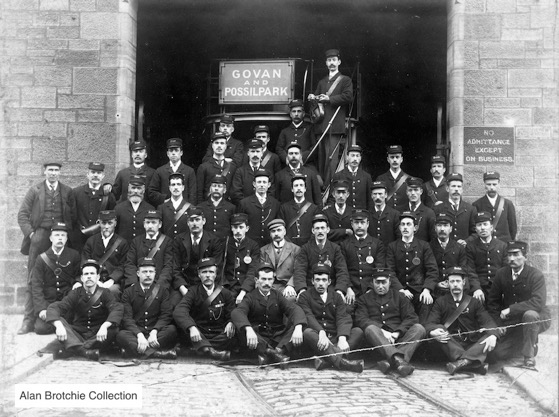
An evocative shot of horse tramway staff at Dalhousie depot, taken in 1899.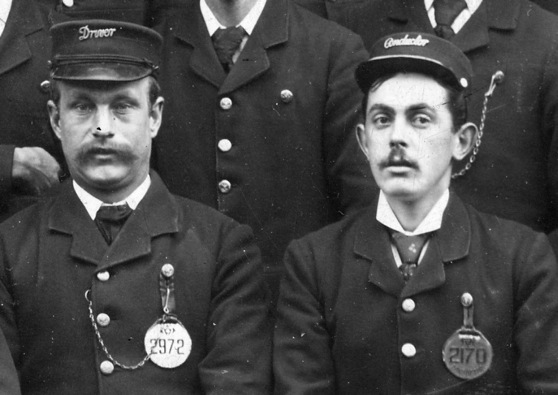
An enlargement of the above photograph showing the kepi-style caps and script-lettering grade badges, 'Driver' and 'Conductor'. Each man also has an enamel licence badge hanging from a specially sewn button on his left breast: the driver's being black lettering on white enamel, and the conductor's black lettering on yellow enamel (see below).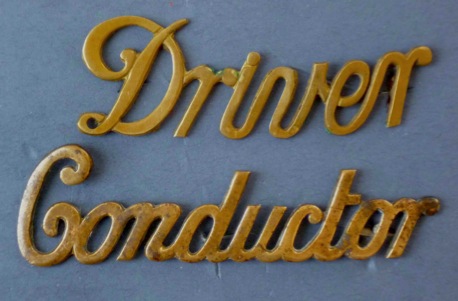
Off-the-shelf script-lettering cap badges, as worn by GCT tramcar staff up until around 1906 — brass.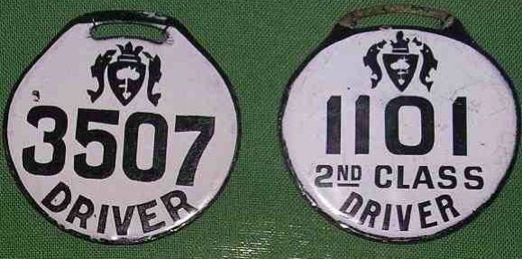
Glasgow Corporation horse tram 'Driver' licence badges, 1st and 2nd Class — white enamel with black lettering. With thanks to the late Kenny Delman.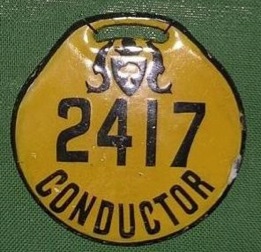
Glasgow Corporation horse tram 'Conductor' licence badges — yellow enamel with black lettering. With thanks to the late Kenny Delman.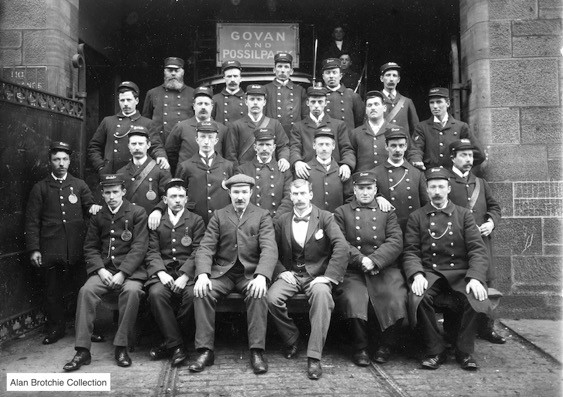
Another official shot of horse tramway staff, again at Dalhousie Depot, and in 1899. All the individuals wearing greatcoats are drivers, which suggests that only this grade was issued with them, presumably due to their exposure to the harsh Glaswegian weather.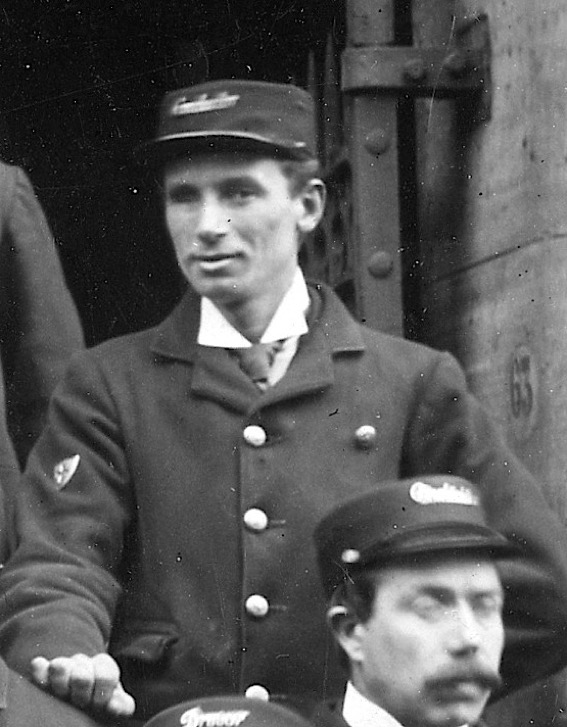
An enlargement of the depot photograph above, showing a conductor; he is wearing a shield-shaped badge on his right jacket sleeve, which is also evident on the sleeve of an inspector in one of photographs depicted below.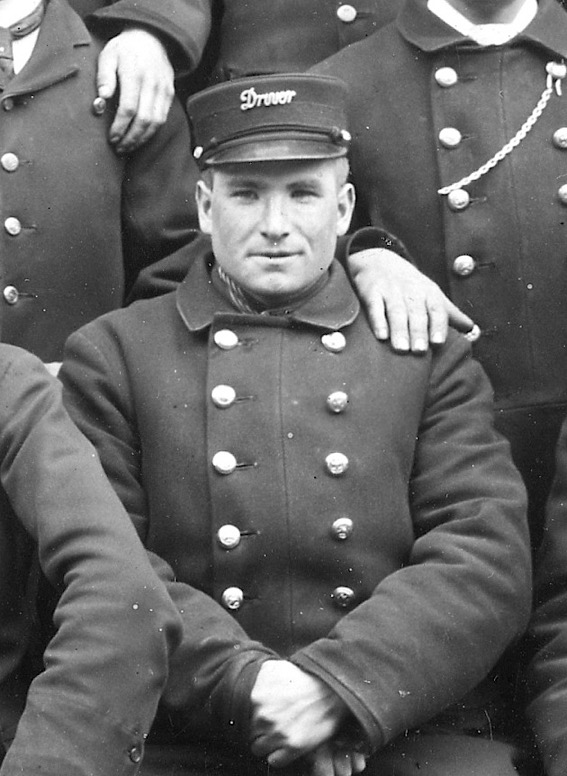
Another blow-up of the above photograph showing one of the drivers in his smart greatcoat. 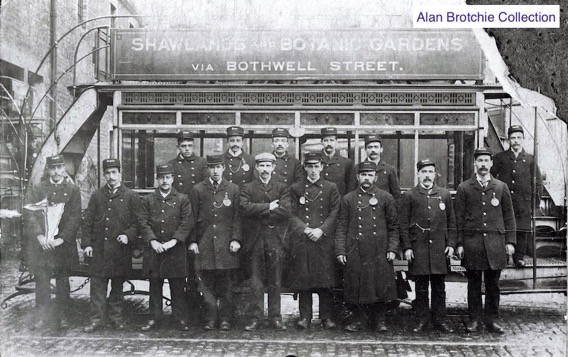
A line up of conductors and drivers at an unknown depot — photo undated, but certainly taken between 1898 and 1902. The drivers are wearing greatcoats, whilst the conductors all have three-quarter-length, single-breasted overcoats.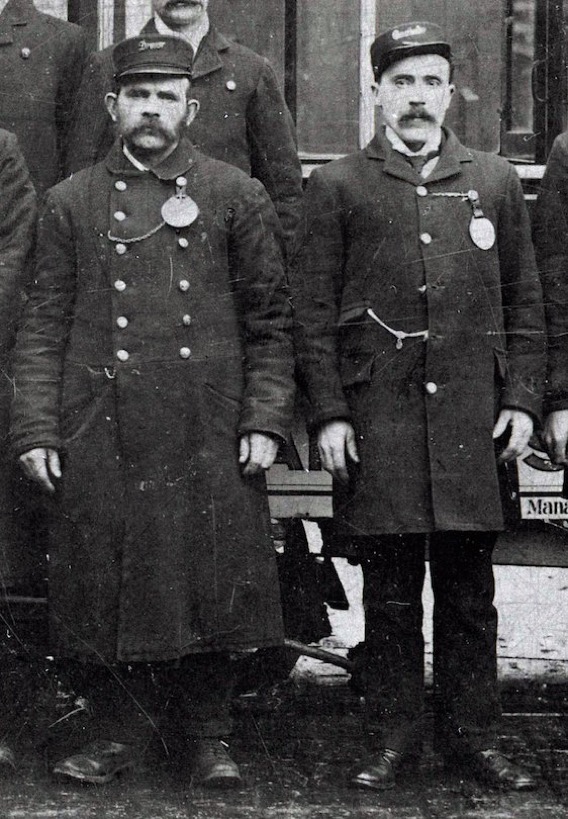
An enlargement of the above photograph, clearly showing the difference in the cut and length of the respective coats. The individual on the left looks like he wasn't a man to brook much messing around!
Motormen and conductors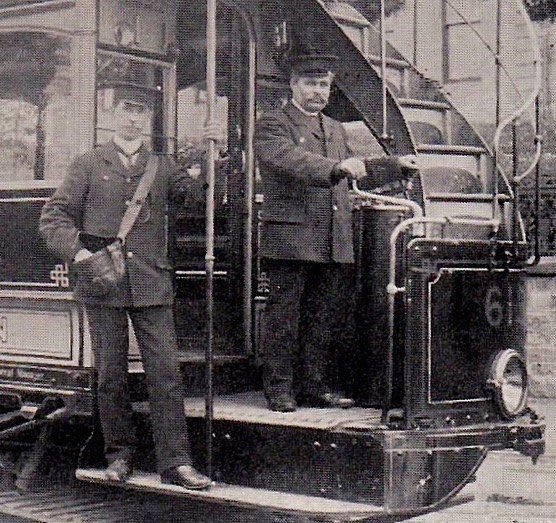
The crew of Tramcar No 619 — the date on the original card is the 9th August 1905, which, given that it is a commercial card, is the latest date the photo could have been taken. Both men are wearing jackets identical to those worn by staff working the horsecar services, but with the kepi-style cap now replaced by a more modern tensioned-crown peaked cap, though seemingly badge-less when the photograph was taken. Photo courtesy of Brian McGarrigle.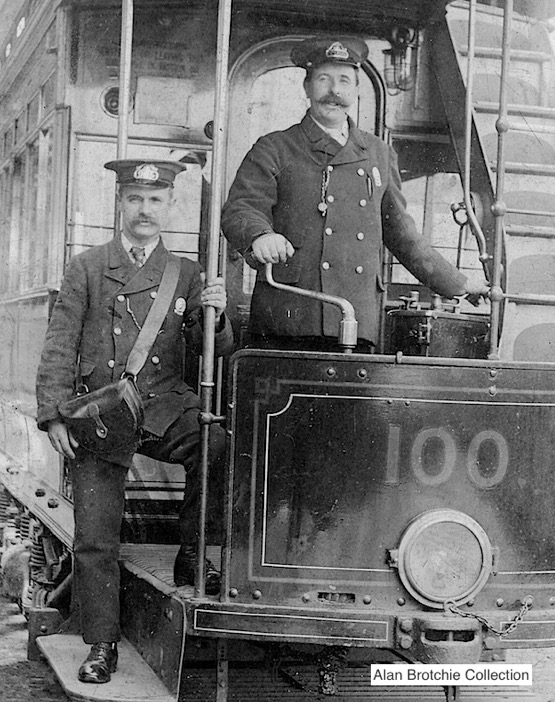
The crew of Tramcar No 100, bound for Mount Florida, pose for the cameraman — photo undated, but probably mid-to-late Edwardian. The jackets are now double-breasted, and the new prominent cap badges are clearly seen. Both men are wearing long-service badges on their left breasts — rather than the right-hand side, which later became the standard — the conductor 5 years, the motorman 10 years, the latter meaning that the photograph was taken at the very earliest in 1905.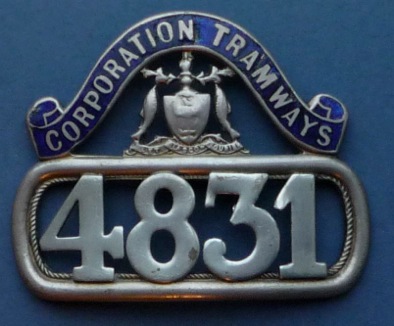
Glasgow Corporation Tramways motorman's/conductor’s cap badge (issued from 1905/6 to 1929) — nickel and blue enamel. Author's Collection.
A poor-quality photograph, but one which shows a GCT points boy (at the right, with points iron in hand). He appears to be wearing a very similar jacket to the tramcar crew, but with high, fold-over collars. His cap appears to be a kepi, and is without a cap badge of any kind. The date is almost certainly 1904/5 as the recently appointed General Manager's name — James Dalrymple — has been painted over the previous incumbent's name on the rocker panel to the left of the conductor. Photo courtesy of the Stephen Howarth Collection.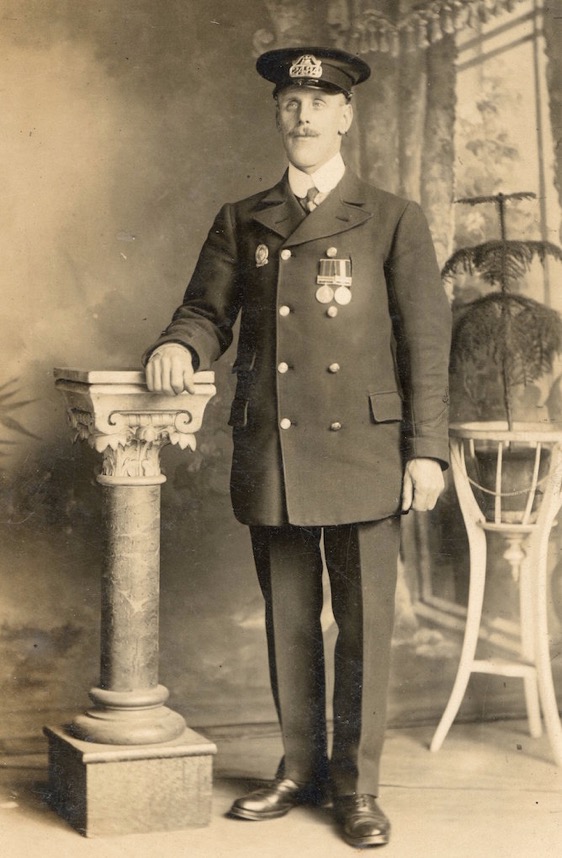
A fine studio portrait of a GCT tramwayman (Employee No 2484), more than likely a motorman — photo undated, but probably mid Edwardian. Author's Collection.
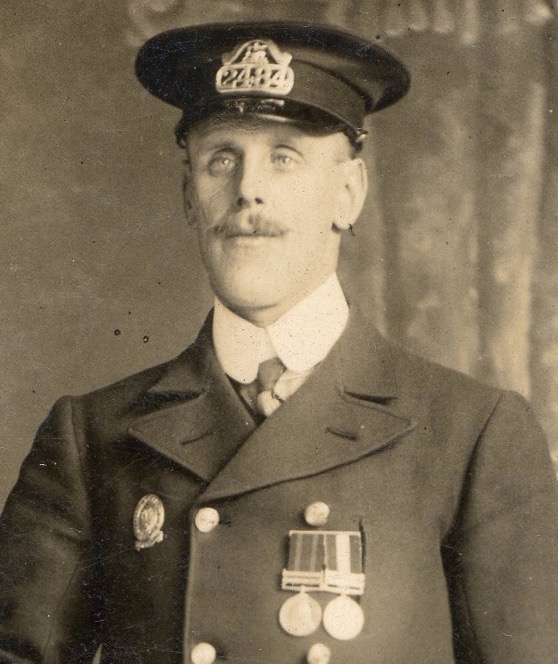
An enlargement of the above photograph showing details of the uniform insignia, including the new cap badge and five-years long-service badge (on his right breast). The medals are presumably of Boer War origin.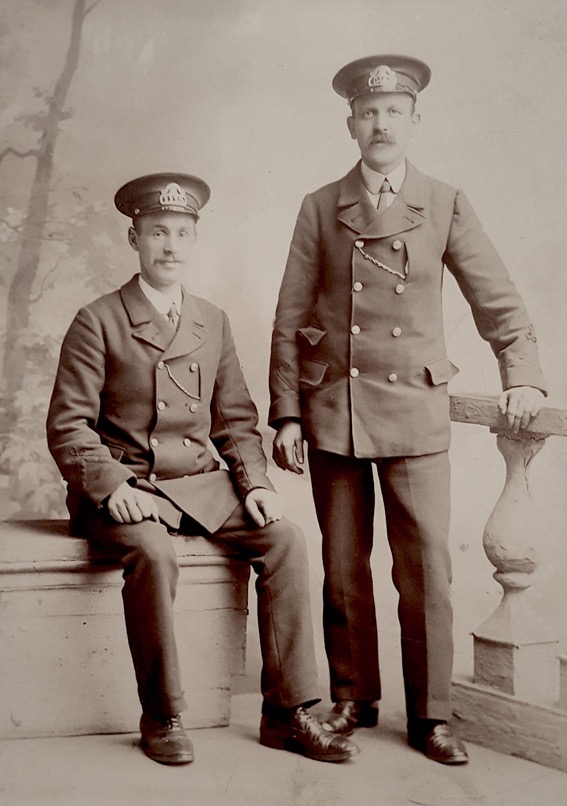
A studio portrait of two GCT employees — photo undated, though probably taken around 1906. The man seated on the left is James Gamley Moir (Employee No 1195), who was born in Forfar in 1876 and moved to Glasgow in the early 1900s to take up work as a GCT conductor. He returned to Forfar some time prior to the Great War, finding work in a slaughter house, but dying in 1922 at the relatively early age of 46. Photo courtesy of David Carnegie, James Gamley Moir's great grandson.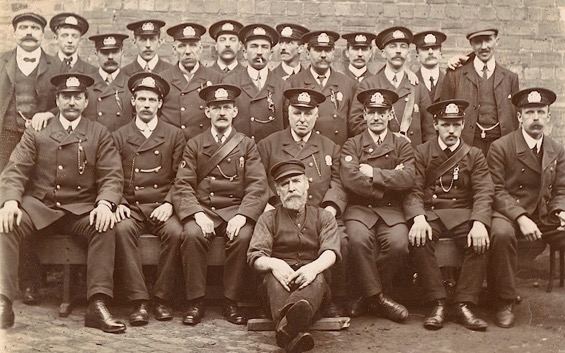
A group of conductors and motormen assembled at an unknown depot — photo undated, but almost certainly taken in the mid-to-late Edwardian era. All the men are wearing the shorter length double-breasted jackets, which were superseded by three-quarter length jackets sometime before 1910. Author's Collection.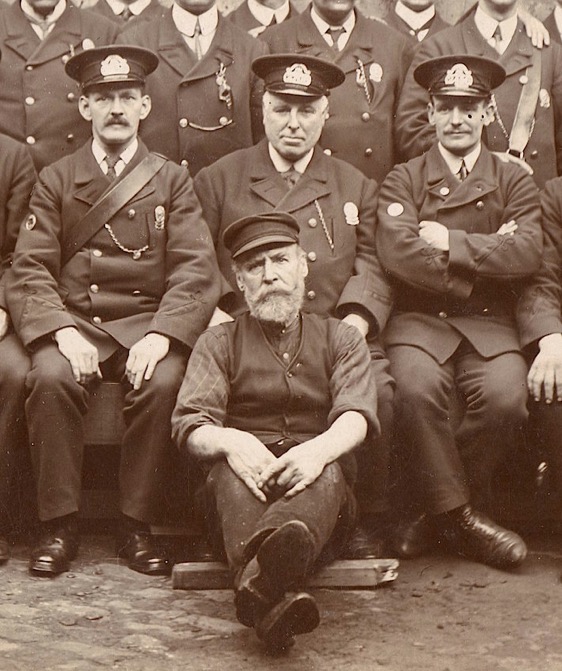
An enlargement of the above photograph showing four of the men, two of whom are wearing 10-years long-service badges, meaning that the photo could have been taken no earlier than 1905. Both the man on the left and the man on the right are wearing a round badge of unknown pattern on their right-hand jacket arms.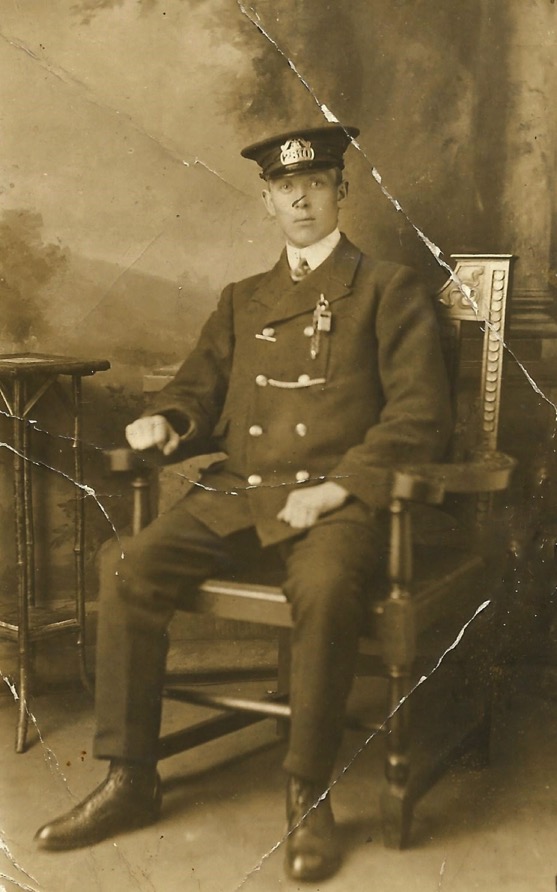
A studio portrait of a GCT motorman (probably), Employee No 2810 — photo undated, but probably taken in the late-Edwardian era, and certainly before 1910 when the style of jacket was changed. Photo courtesy of the Stephen Howarth Collection.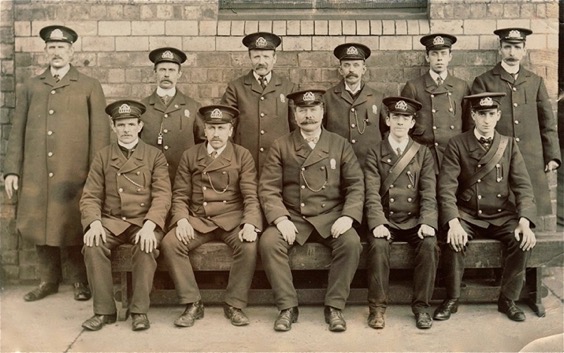
A postcard photo taken at Coplawhill depot circa 1908. The postcard was sent from Jack — presumably one of the men in the photo — to his girlfriend Jeannie Simpson in Montrose, and was franked in 1908. The identifiable badge numbers are as follows: 1717 (front left), 2155 (front 2nd left), 1578 (front middle), 192 (front 2nd right), 467 (back third left), 2190 (back, 3rd right), 263 (back 2nd right). Photo courtesy of the Brian McGarrigle Collection.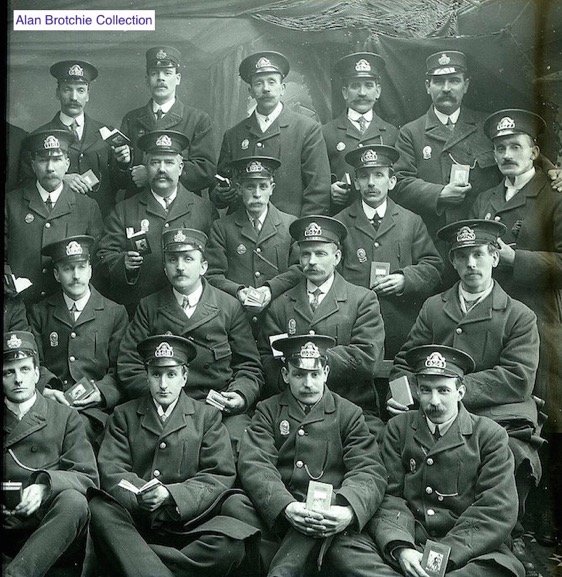
An unusual studio photograph of 18 GCT staff (a mixture of motormen, conductors and inspectors). It is probably the Pocket Testament League, which was formed to encourage people to read the bible every day, and to carry a pocket testament with them (the book they are holding is very probably 'The Illustrated Bible' which was apparently given to the men for free). Five of the men are wearing 15-years long-service badges, suggesting that the photo was taken in 1910 or 1911, but certainly not later than 1915. I am indebted to Alan Brotchie and Brian Longworth for the background information.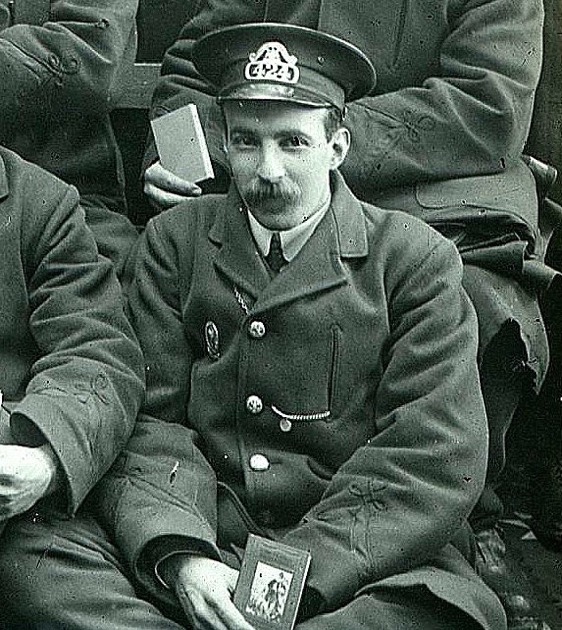
An enlargement of the above photograph showing one of the tramcar staff (Employee No 424); he is wearing the new single-breasted, three-quarter-length jacket/coat which appears to have been introduced around 1910. The uniforms are clearly of a very high quality, with decorative embellishment on the cuffs.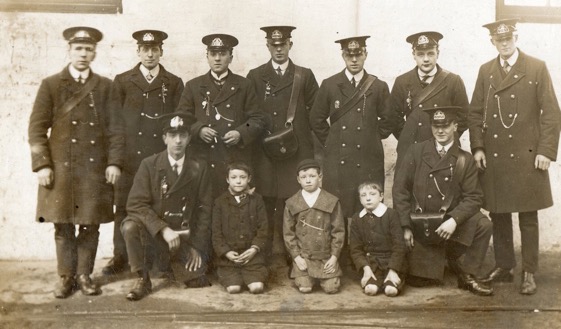
A group of GCT tramwaymen assembled for the photographer at an unknown depot — photo undated, but probably taken shortly before or just after the Great War. Curiously, all are relatively young, with just a single five-years long-service badge between them. Left to right, back row: unknown, unknown, No 1554, No 2378, No 1348, No 2934, No 961; front row, unknown, No 2999. Author's Collection.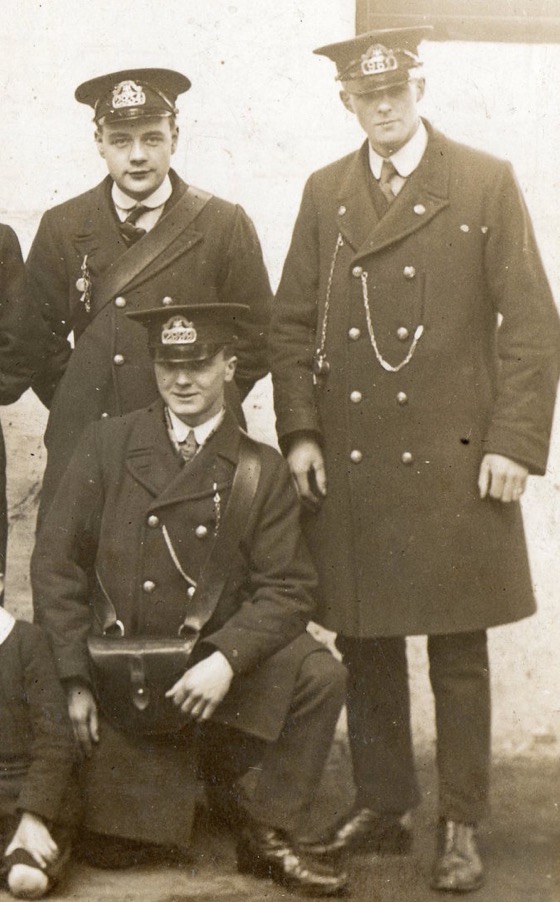
An enlargement of the above photograph showing Employees No 2934, 961 and 2999.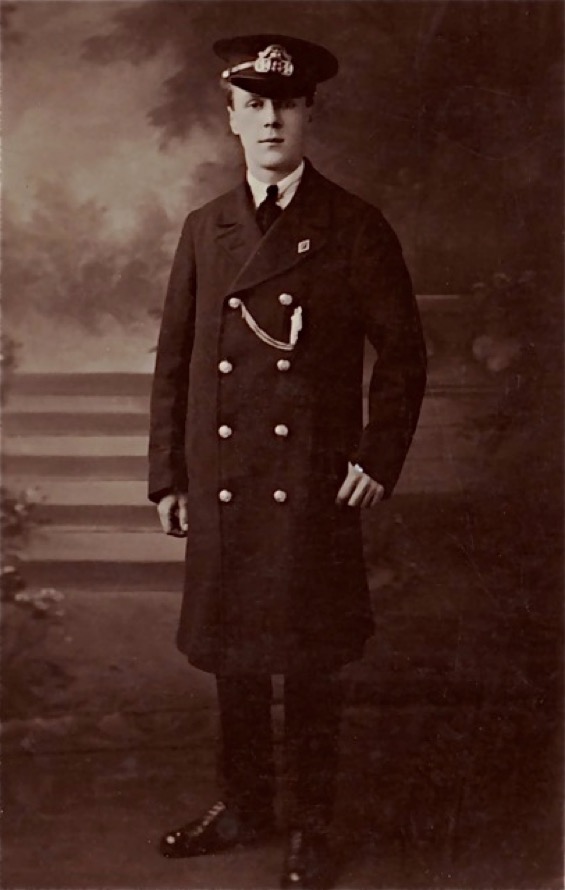
A GCT motorman, resplendent in large overcoat; photo taken circa 1914. With thanks to Brian McGarrigle.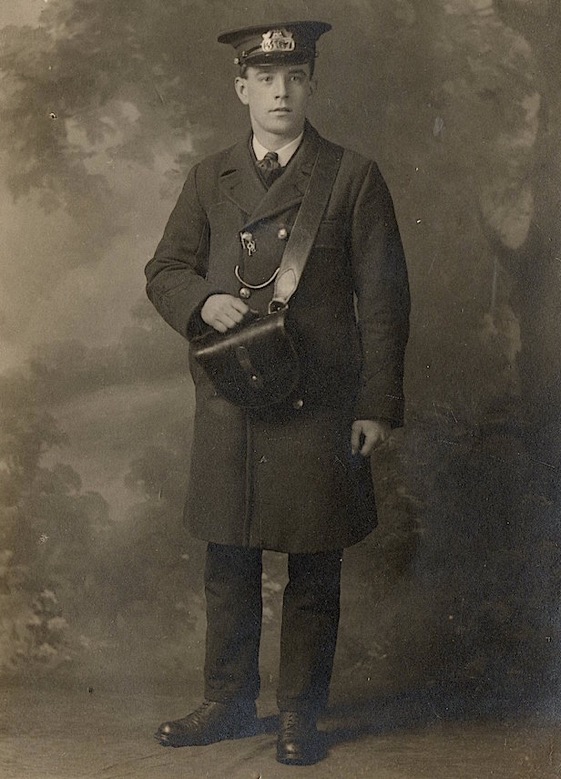
Another studio portrait of a GCT conductor (Employee No 3167) — photo undated, but probably taken around the time of the Great War. Author's Collection.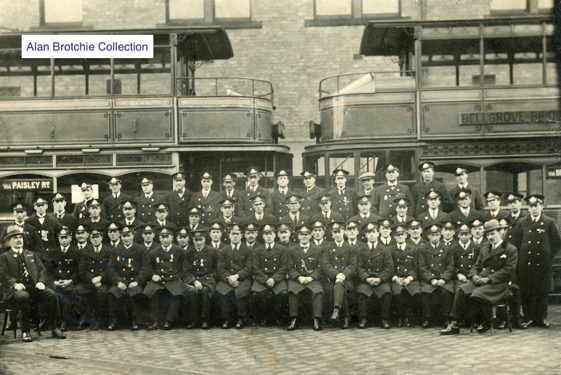
A staff photograph taken on the forecourt of Govan depot — photo undated, but from the style of the non-uniform hats, the war medals and lack of moustaches, probably taken in the mid 1920s. All the uniformed staff are motormen and conductors (there are no inspectors) and of relatively short service judging by the long-service badges, possibly reflecting the heavy toll of the Great War.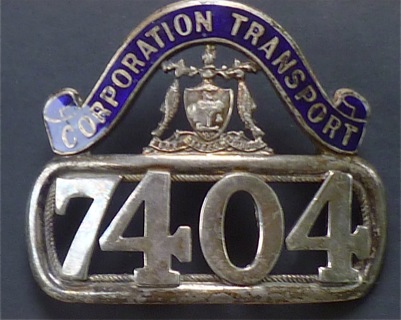
Glasgow Corporation Transport cap badge (new issues from 1929 onwards) — nickel and blue enamel. Author's Collection.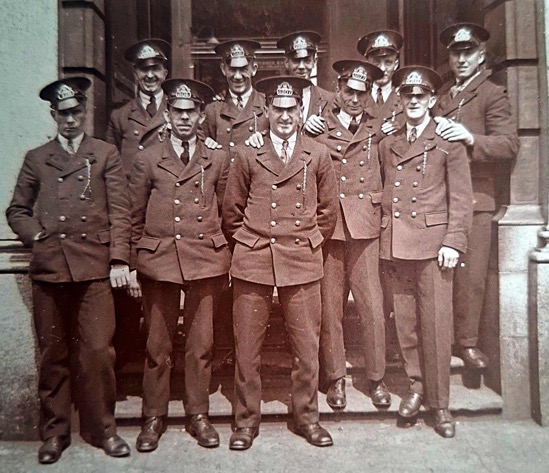
A photograph of a group of GCT employees, seemingly all conductors, outside an unidentified building, possibly the Clothing Store or the Training School. The date is probably the late 1930s or early 1940s, as some of cap badge numbers are very high; those that can be made out are: 248, 2918, 3877, 4207, 304, and 128. Curiously, many of the subjects are relatively old, yet they do not have a single long-service badge between them. Photo courtesy of Mrs L. Ross. My thanks to Brian McGarrigle for the background information.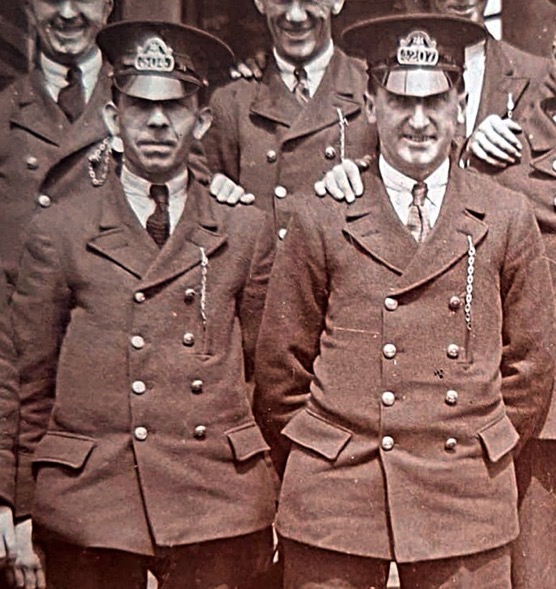
An enlargement of the above photograph showing Employees 304 and 4207 in the smart, shorter jackets worn at the time.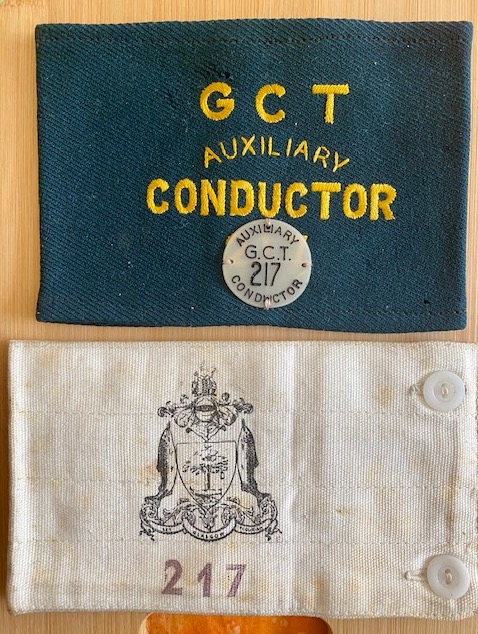
World War II GCT Auxiliary Conductor No 217 armbands, Lincoln Green serge, and white linen or canvas; the latter is the earlier of the two, the higher quality serge example replacing it. These were issued to members of the travelling public (volunteers) during the Second World War, who would have assisted the conductor in return for reduced or free travel. With thanks to Brian McGarrigle.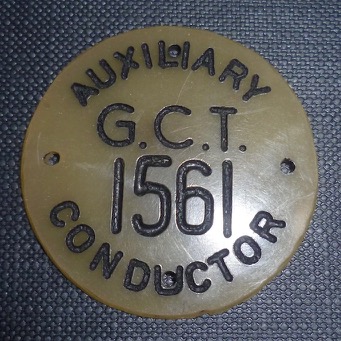
GCT auxiliary conductor's sew-on badge — possibly made of celluloid. Author's Collection.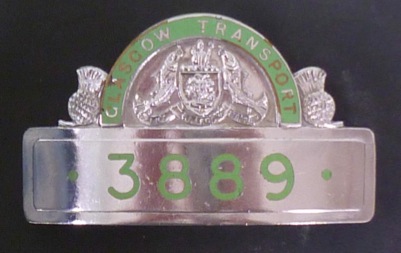
Replacement cap badge issued to male traffic staff from 1960 onwards, but only to staff who had either lost their existing badge or whose badge was damaged beyond repair. With thanks to Brian McGarrigle for this information.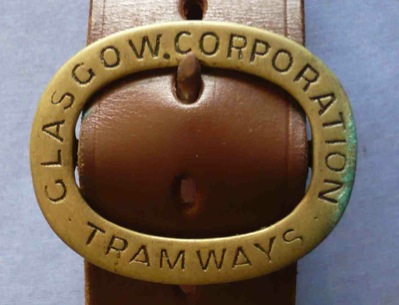
Strap buckle from a conductor's cash bag — brass.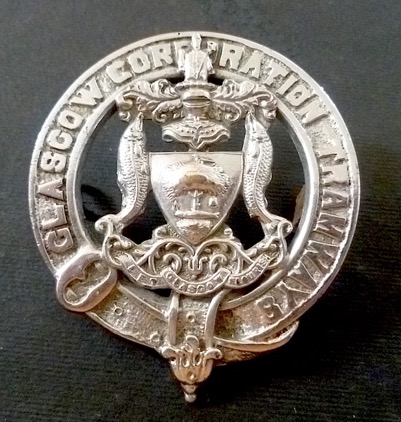
Not strictly speaking a uniform item, but a Glengarry cap badge, probably worn by members of the Glasgow Corporation Tramways Pipe Band — brass. Author's Collection.
Senior staff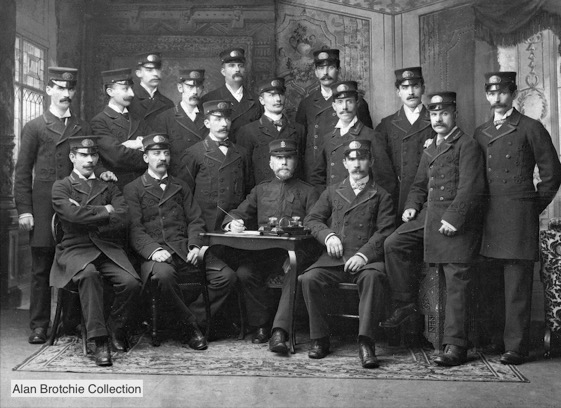
A formal studio portrait of GCT inspectors and the Chief Inspector (seated at the desk), taken in 1905.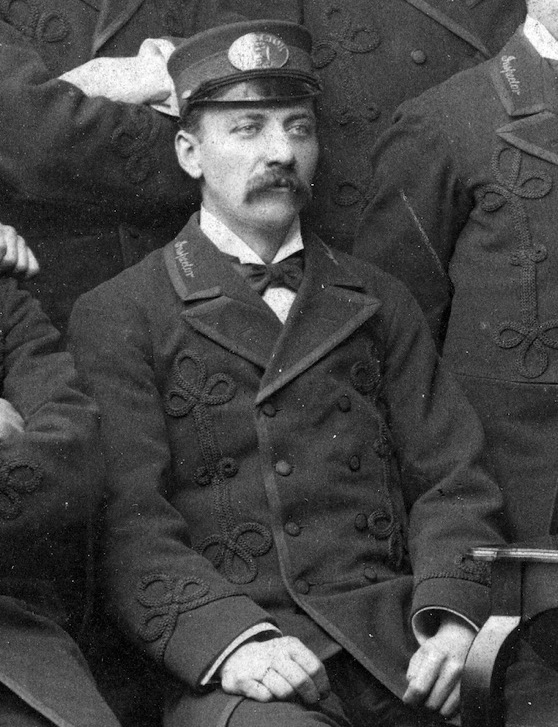
An enlargement of the above photograph showing details of the elaborate uniforms, as well as the prominent oval cap badge (see below for an example).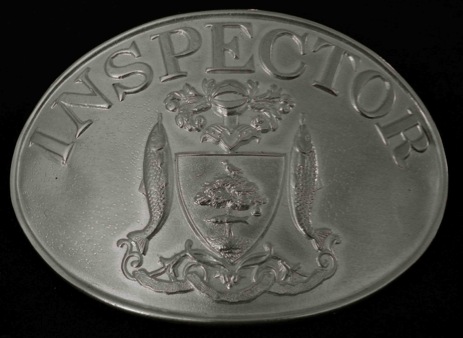
GCT inspector's cap badge — used until around 1905/6 — nickel. With thanks to Brian McGarrigle.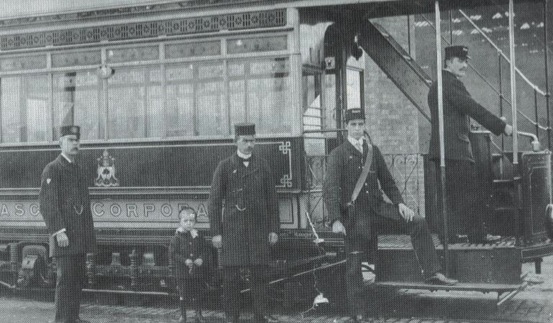
Two inspectors, a conductor and a driver pose with an unidentified tram car in 1900. Note the shield-shaped badge on the arm of the left-most inspector. With thanks to the Scottish Tramway and Transport Society. 
A GCT inspector, taken from the Pocket Testament League photograph shown above — circa 1910. The new jackets and cap badges (see below) were probably introduced around 1906.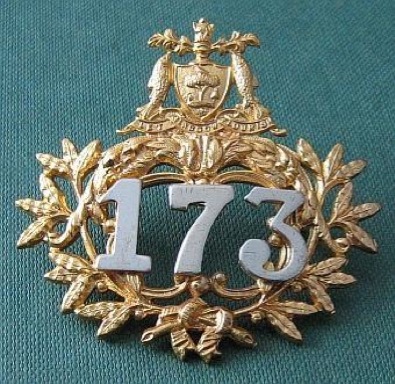
GCT Inspector’s cap badge (issued from 1905/6 onwards) — gilded brass.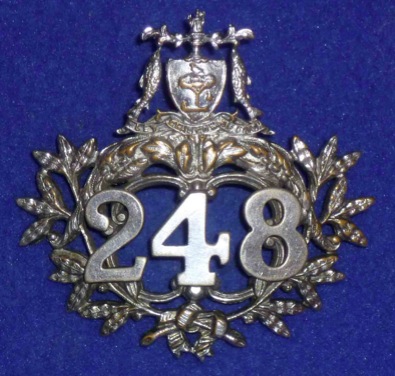
GCT Depot Inspector’s cap badge — nickel. Author's Collection.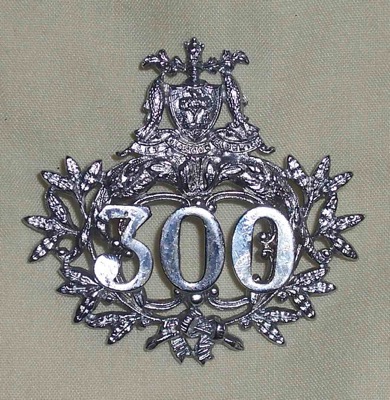
GCT Depot Inspector’s cap badge — chrome. Author's Collection.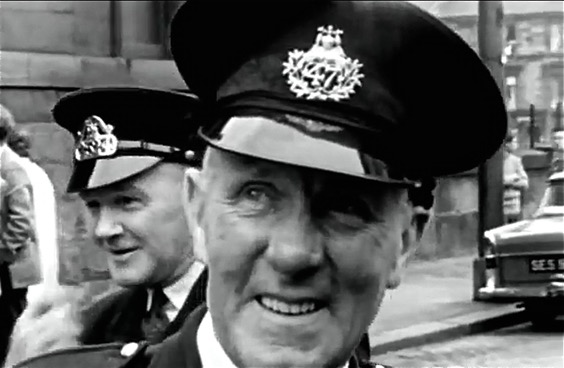
Glasgow Corporation Tramways Inspector No 47 — photo undated, but possibly taken in the last week of the trams in 1962. Photo courtesy of Stephen Howarth.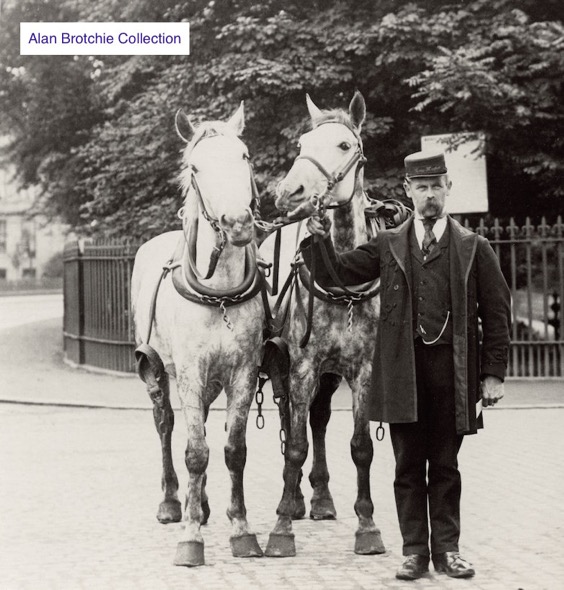
An excellent study of a GCT timekeeper with a pair of tramway horses near the Royal Crescents at the west end of Sauchiehall Street — photo undated, but certainly taken between 1896 and 1902.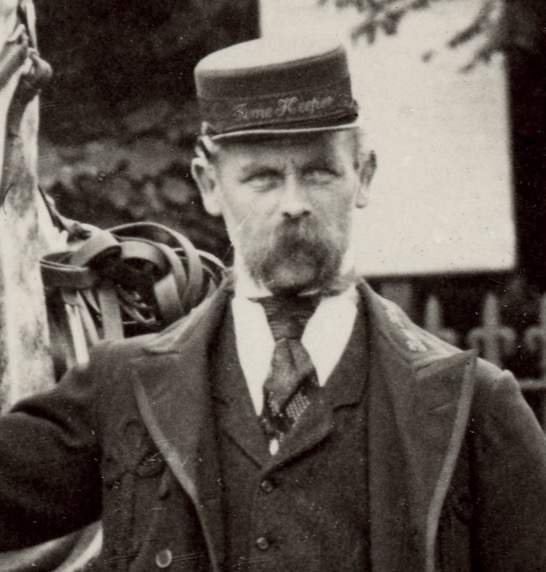
An enlargement of the above photograph showing details of the timekeeper's uniform. His long coat is identical to those worn in the same period by inspectors, save for the embroidered grade on the collars; the cap is also similar, but with the grade embroidered on a hat band rather than the prominent nickel cap badges worn by inspectors.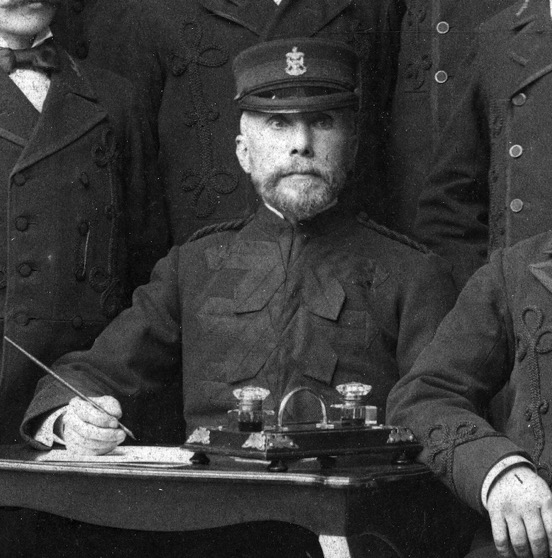
A blow-up of the inspectors' group photograph above, showing the Chief Inspector. He is wearing a Glasgow municipal-device badge on his cap (see below for an example).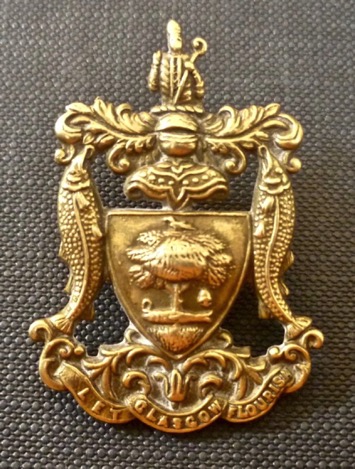
Glasgow municipal-device chief inspector's cap badge — brass. Author's Collection.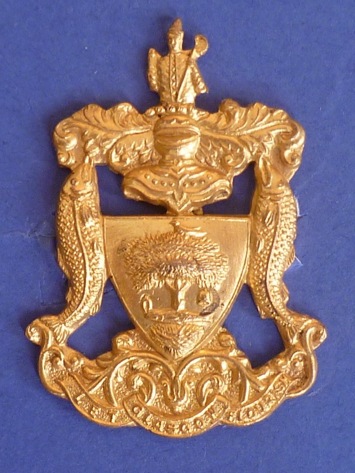
A virtually identical badge to that above, but this time in gilded brass. This is certainly more modern than the brass version, and is very likely an example of the epaulette badges issued to Chief Motor Inspectors from 1946 onwards. Author's Collection.
Female staff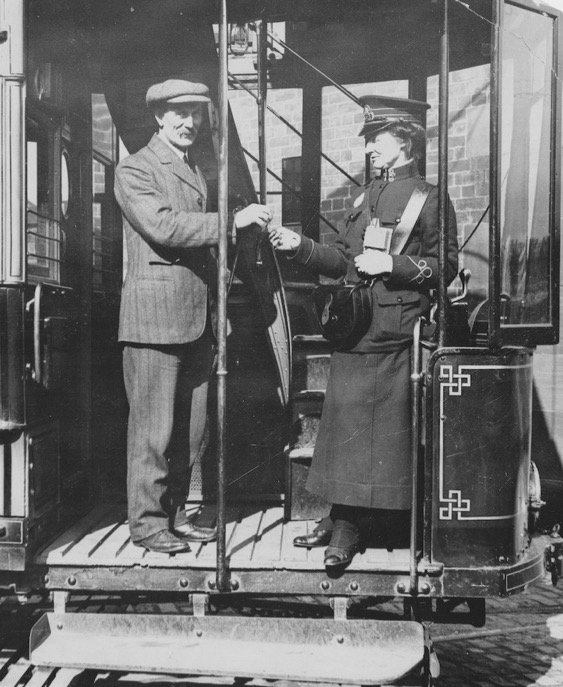
A press photo taken on the 25th April 1915, with one of the first two ladies to pass out as a trained conductress. Author's Collection.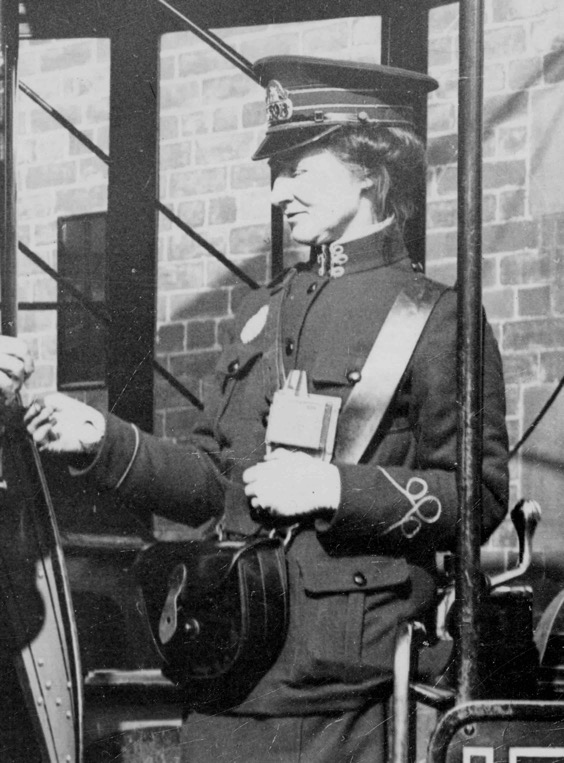
An enlargement of the above photograph showing details of the uniform. The jacket bears plain buttons, as well as what would appear to be a cloth badge of some description (on the subject's right-hand breast). The tall stand-up collars and the jacket cuffs both bear gold piping embellishments, as does the tensioned-crown peaked cap. The subject's cap badge number ends in 398.
A photograph that was very probably taken on the same day — 24th April 1915 — as the preceding photograph, this time out on a service aboard Tramcar No 240.
An enlargement of the above photograph, which suggests that the conductress is the same lady shown in the press photograph above.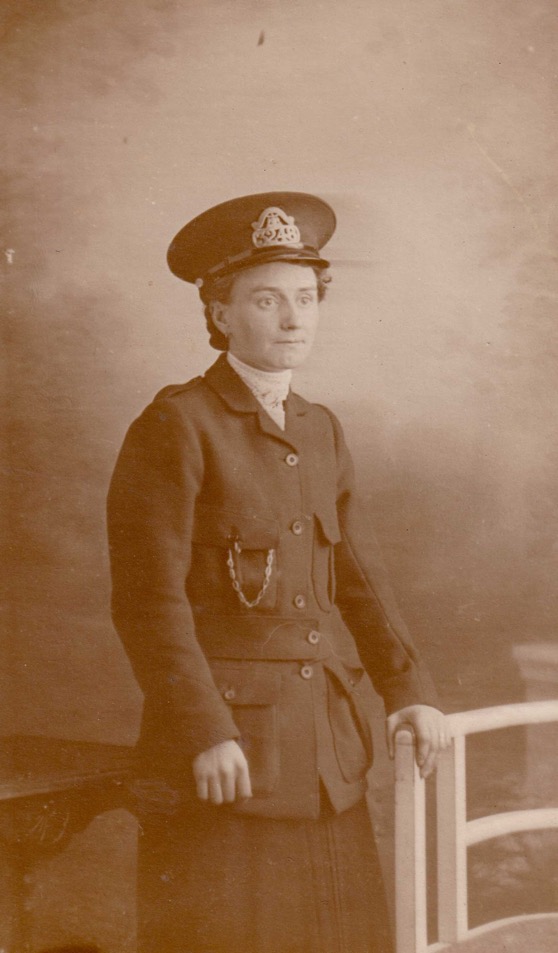
A studio portrait of a GCT employee, almost certainly a conductress — photo undated, but probably taken in summer 1915 given that she is wearing an unpiped cap, a jacket without the usual GCT buttons, and what would appear to be a plain skirt. Photograph taken in Gale's Studios. Author's Collection. 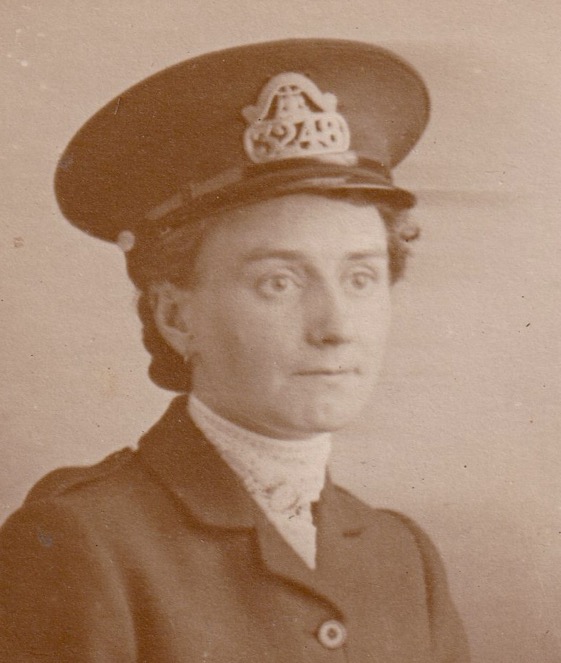
An enlargement of the above photograph, which reveals the subject's cap badge to be No 3248.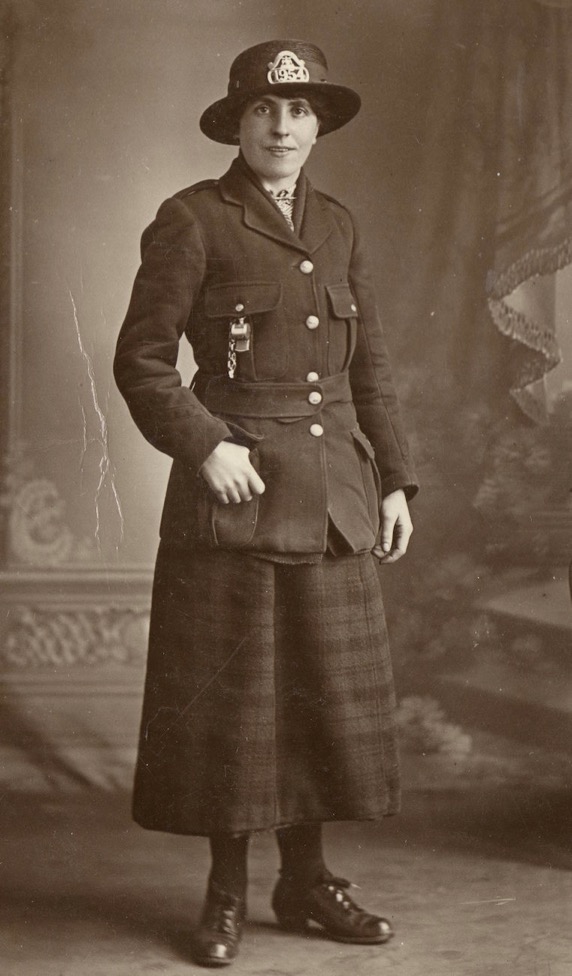
A studio portrait of a GCT female employee (No 1954), probably a conductress — photo undated, but certainly taken during the Great War. Rather than the tensioned-crown caps seen in the preceding photographs, the subject is wearing a stylish straw bonnet, which was possibly intended for summer use only (issued from 1915 onwards), though this is far from certain. Author's Collection.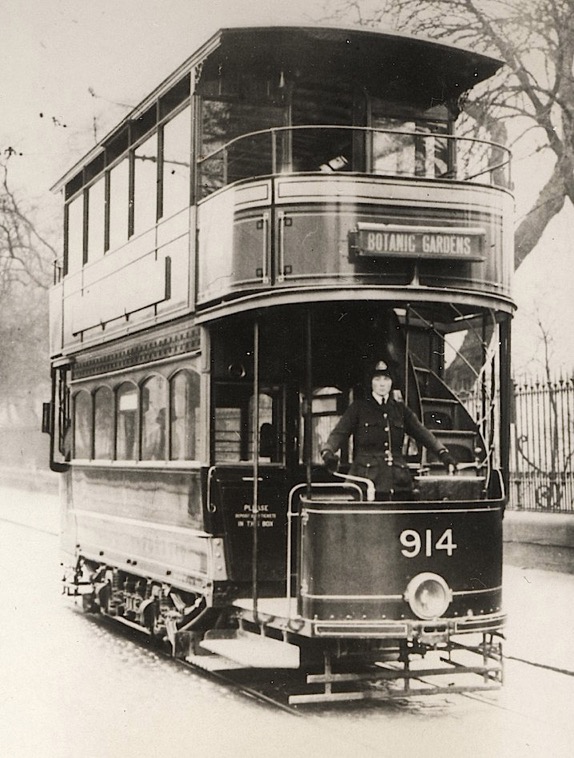
A motorwoman at the controls of Tramcar No 914, which is standing in Great Western Road next to the Botanic Gardens. The photo probably depicts the first motorwoman — apparently called 'motoresses' in Glasgow — so was either taken in late 1915 during training, or early 1916 when she would have formally passed out; thanks to Brian Longworth for this information. Author's Collection.![]()
A lovely studio portrait of GCT motorwoman No 1258, clearly showing the single-breasted tunic, along with a baggy motor cap bearing the standard cap badge. The text reveals that she was named 'Lill' and that she was "still at the driving" and that "this week finishes my 30 days probation". Author's Collection.
A poignant studio portrait of what is in all probability a family group, including a GCT Great War female employee — photo undated, but certainly taken between 1916 and 1918. The older man on the left is wearing the uniform of the Argyle and Sutherland Highlanders. The photograph was taken in State Studios, 125 Canning St., Glasgow. Author's Collection.
An enlargement of the above photograph showing the lady, who given her uniform and cap, is probably a motorwoman. He cap badge number ends in 'x371'.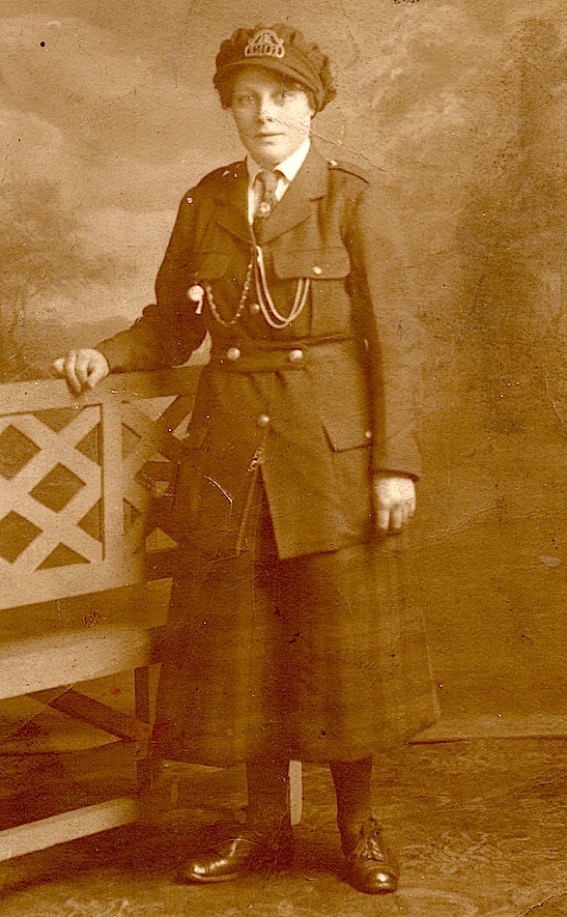
Another studio portrait of a GCT female employee (No 1201), again very probably a motorwoman. The rear of the card states: "4th July 1918. With love from Cathie". Author's Collection.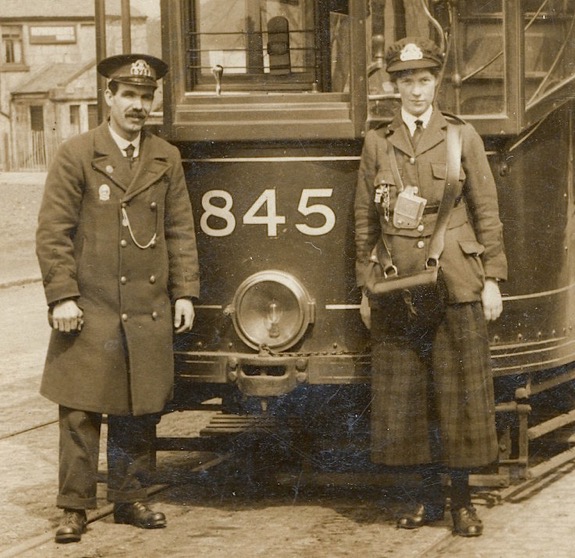
A motorman (Employee No 571) and a conductress pictured with Tramcar No 845 on a Hyndland's service (possibly on Clarence Drive) — photo undated, but certainly taken during or shortly after the Great War. Author's Collection.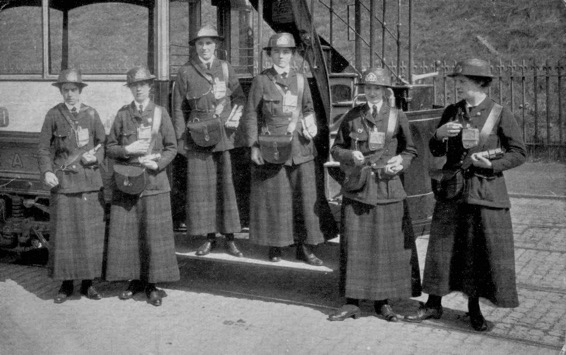
A group of six Great War GCT conductresses, all in tartan skirts and dark-green straw bonnets.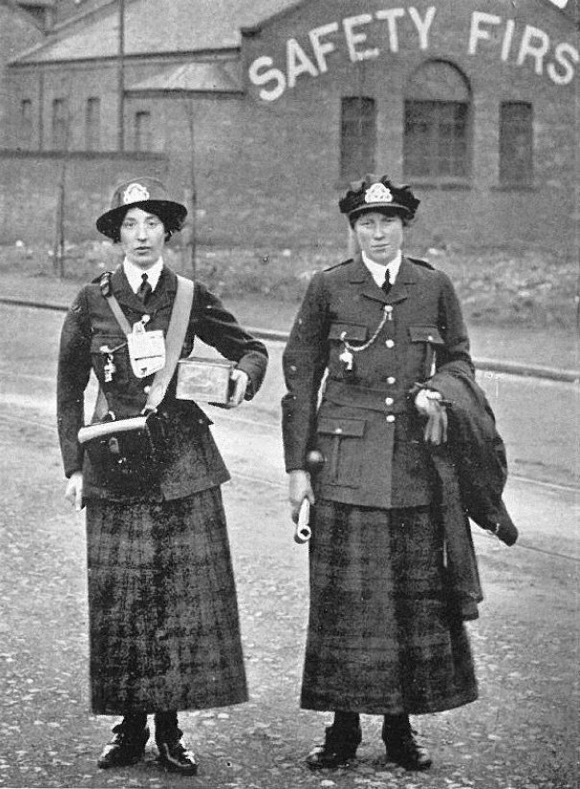
A nice study of a Great War GCT conductress and a motorwoman, the former in waterproofed straw bonnet and the latter in a baggy peaked cap.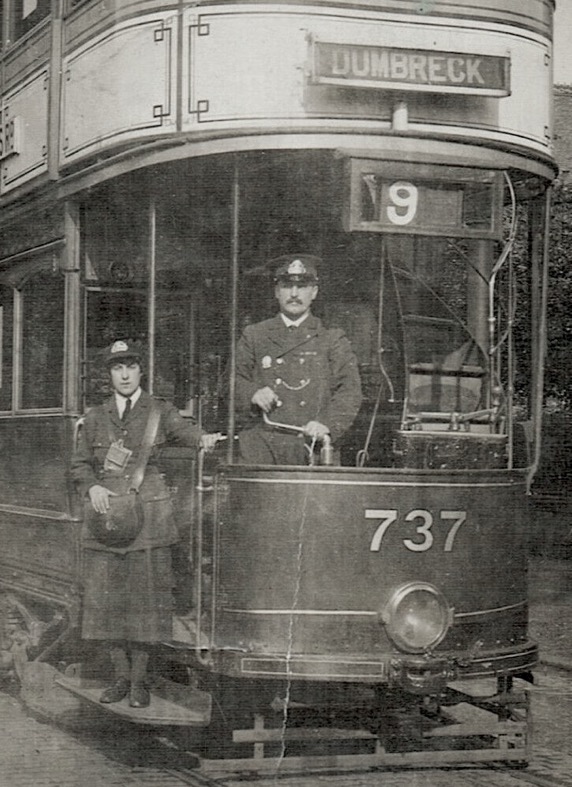
A conductress and a motorman with Tramcar No 737 on a service to Dumbreck — photo undated, but certainly taken during or shortly after the Great War.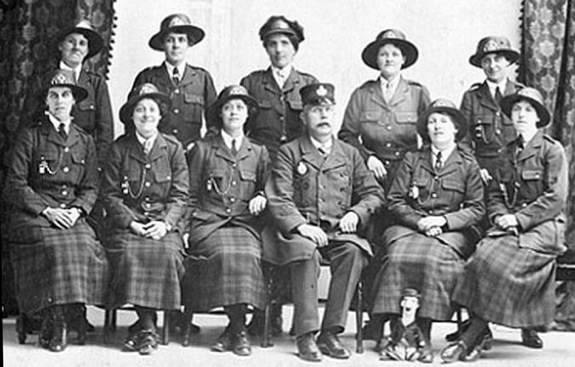
A group of GCT female employees pose during the Great War. Note the inspector with double-breasted three-quarter-length coat, later-period cap badge and 20-years long-service badge (on his right breast). With thanks to Brian McGarrigle.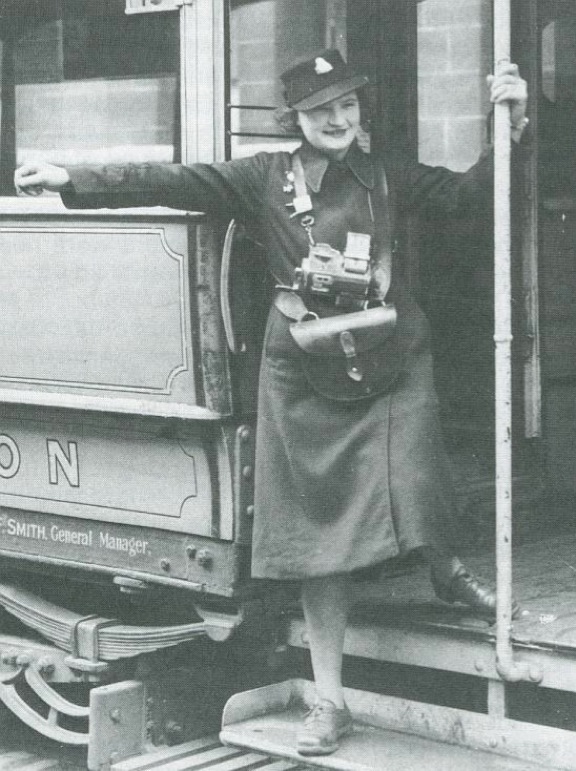
Conductress Letitia (Letty) Duncan, pictured on the platform of a GCT tramcar during the Second World War. Miss Duncan's image, very possibly the one shown here given its staged nature, was used in GCT recruiting campaigns. Miss Duncan married GCT Motorman Herbert (Bert) Kitson in 1942, though she sadly died of tuberculosis at the end of the war. Glasgow's conductresses were ubiquitously known as ‘clippies’, and were provided with military-style field caps with long cloth-covered peaks; these hats bore a badge that was only issued to female employees (see below for an example). With thanks to Ewan Smith (Letty and Herbert's grandson) for the background information, and to the Scottish Tramway and Transport Society for the image. 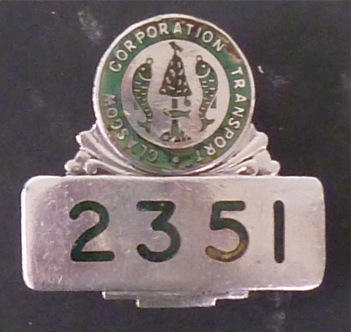
GCT conductress cap badge — chrome with green enamel inlay. This badge was introduced during the Second World War and was worn right through to closure of the system. Author's Collection.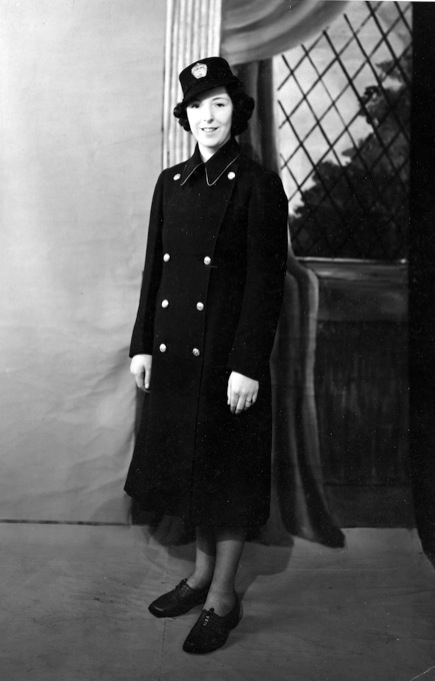
A GCT publicity photo — 1941. The lady in question was apparently a member of the secretarial staff rather than a bona fide 'clippie'! Thanks to Brian McGarrigle for this information. Photo courtesy of Alan Brotchie.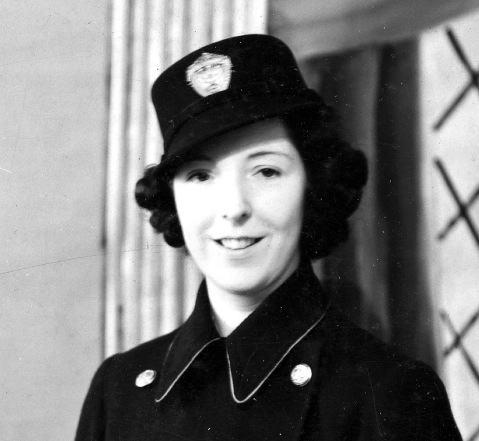
An enlargement of the above photograph, which clearly shows that the lady in question is wearing a large 30-years long-service badge, which was apparently all they had to hand — thanks to Brian McGarrigle for this information!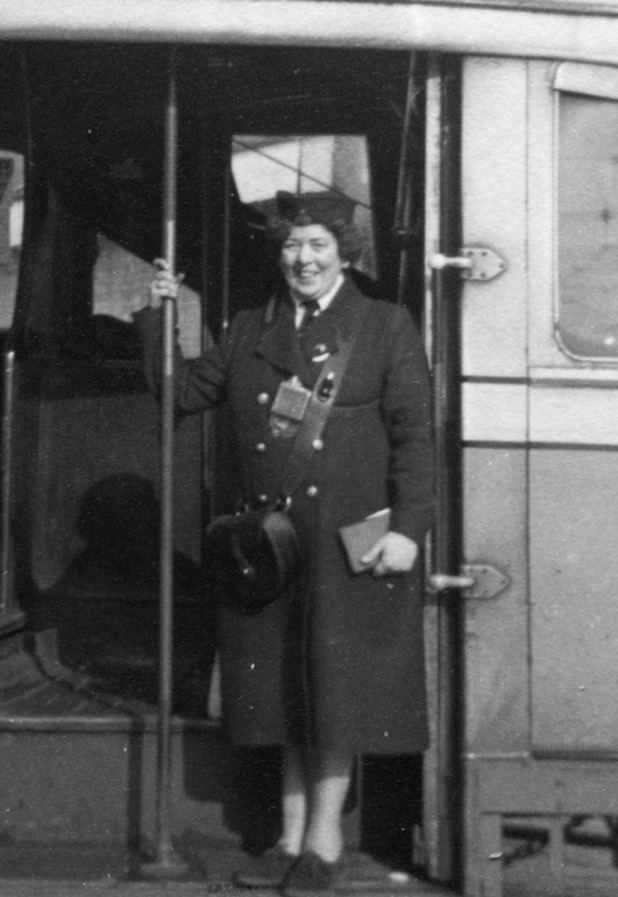
GCT tram conductress Mary McGee — photo undated, but probably taken in the 1950s. She is wearing a double-breasted topcoat, and a brimless hat akin to the type worn by air stewardesses; the latter bears the standard female-employee cap badge.
GCT Long-Service Badges
The GCT was certainly in a class of its own when it came to recognising the longevity of staff service. Long-service badges were first issued in 1900 (following a competition to select a suitable design) to recognise 5-years continuous service from the founding of the municipal system (in 1894). Further badges were eventually produced to mark each subsequent 5-year anniversary (up to 40 years service). It seems more than likely that it was intended to add a '5-year' bar for each further five years of service, but this was only done for the 10 years' service badge, following which completely new designs were introduced (once again involving competitions). Long-service badges were of course also issued to uniformed staff who had joined since the founding of the department, upon completion of each unit of 5 years' service.
Long-service badges were commonly worn on the right-hand side of the tunics (usually at breast level), and thus had two fixing lugs on the back; they were quite large and were therefore a prominent uniform adornment. Staff were expected to hand their old badges in when receiving a new one, with the former being melted down; the heavy wear on many of these badges is due to the soft metal (silver for 20 years and above) and the fact that employees were expected to keep their badges and buttons polished, and indeed took great pride in doing so. The 35-years and 40-years badges exist in three forms: the standard large tunic size (for tramcar staff); a smaller watch chain fob (as a permanent keepsake); and a smaller pin-back version, the purpose of which is not absolutely clear, though they were possibly issued to clerical staff.
The 40-years service badges were first issued in 1934 (40 years on from the commencement of municipal ownership) and therefore only exist in Glasgow Corporation Transport form. The very first issues of the 40-years badge (i.e., in 1934) bore the legend ‘1894-1934’, whilst those in subsequent years (i.e., from 1935 onwards) bore the legend ’40 YEARS’. Only 18 staff (all presumably male) were eligible for the 1934-issued badges due to so many being killed during the Great War, so in all likelihood, only 36 were ever made (18 badges in solid silver, along with 18 fobs in silver gilt). Several variations in enamel, wording and material are known for the 40-years 'Transport' fobs and badges.
The lucky recipients of long-service badges turned up for a presentation, were given a celebratory drink (non-alcoholic), and were then expected to return to work for the rest of the day!
Tramways Department Badges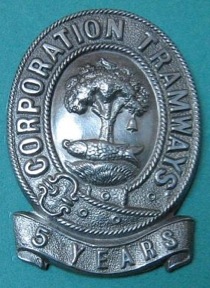
5-years service — nickel. With thanks to the late Kenny Delman.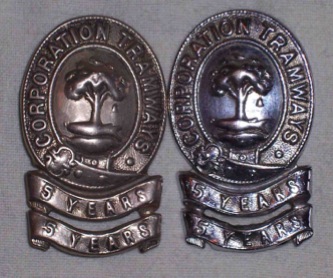
10-years service badges — nickel and chrome. Note that the chrome example is actually a nickel badge that has been rechromed, either by an employee or a collector.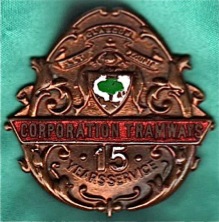
15-years service badge — brass. With thanks to Brian McGarrigle.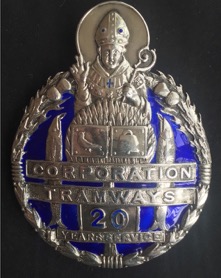
20-years service badge — solid silver. With thanks to Brian McGarrigle.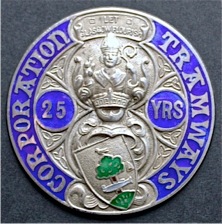
25-years service badge — solid silver. With thanks to Brian McGarrigle.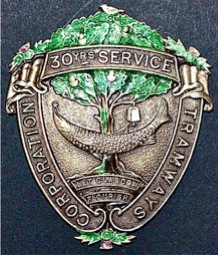
30-years service badge 1928 — solid silver. With thanks to Brian McGarrigle.
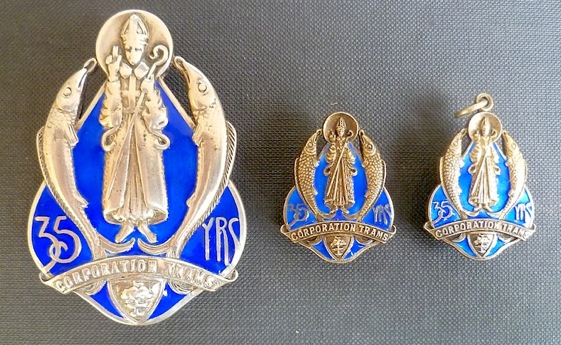
35-years service badge male (1929), pin-back (1932) and keepsake fob (1929), all solid silver. The 1932 silver date stamp on the middle badge probably indicates that the manufacturer had a stock which was date stamped when supplied, as this is fully three years after the demise of the Tramway Department. Author's Collection.
Transport Department Badges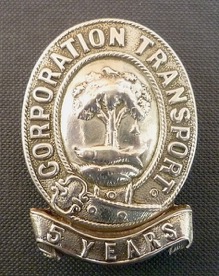
5-years service badge — nickel. Author's Collection.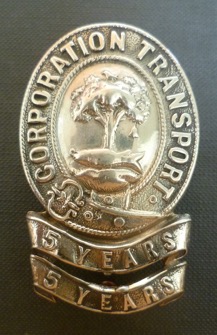
10-years service badge — nickel. Author's Collection.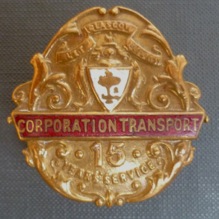
15-years service badge — brass. Author's Collection.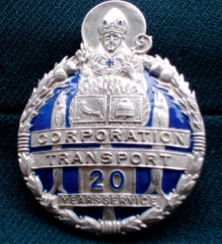
20-years service badge — solid silver. 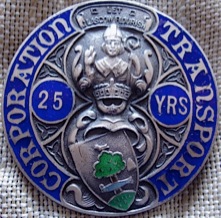
25-years service badge — solid silver. With thanks to Brian McGarrigle.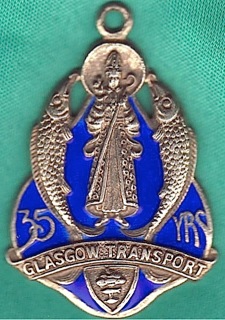
35-years service employee's keepsake fob — solid silver. With thanks to Brian McGarrigle.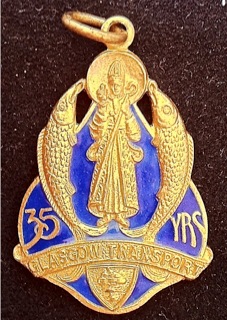
35-years service employee's keepsake fob — silver gilt. With thanks to Brian McGarrigle.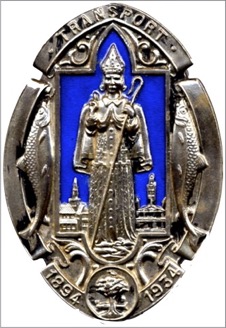
40-years service badge 1934 (inaugural issue) — solid silver. With thanks to Brian McGarrigle.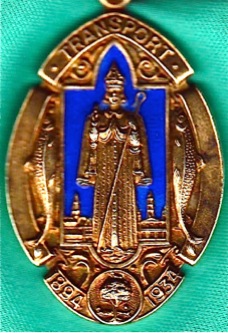
40-years service fob 1934 (inaugural issue) — solid silver gilt. With thanks to Brian McGarrigle.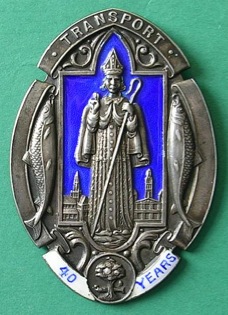
40-years service badge — solid silver. With thanks to the late Kenny Delman.
40-years service fob — solid silver. With thanks to Brian McGarrigle.
40-years service fob with 'YRS' abbreviated — silver gilt rather than silver. With thanks to Brian McGarrigle.
40years service fob 1947 — gilt lettering with blue enamel inlay — solid silver gilt. Author's Collection.
Many thanks to the late Kenny Delman (Glasgow Transport Badges) and Brian McGarrigle for the vast majority of the research, wording and photos.